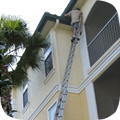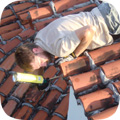-
info@aaanimalcontrol.com
Call us for help in your town
Humane Wildlife Education
How To Get Rid Of & Remove Bats In the Attic
Need bat removal in your hometown? We service over 500 USA locations! Click here to hire us in your town and check prices - updated for year 2020.
Bats love to live in the attics of homes and other buildings. Attics provide all of the roosting requirements of many of the colonizing bats, particularly
female bats who need a warm, safe place in which to raise their young. You can attempt to remove them yourself with the below instructions, but it is very
difficult. It took me years to learn, along with the hundreds of wildlife professionals who work with us. Your best option for an effective and legal
bat removal project is probably to hire our professional help. You may want to read how much does bat removal cost if
that is one of your concerns. The below steps are the ones we take to solve the problem of bats in the attic.
Step 1: Determine whether or not there are baby bats in the attic, along with the adults. Bats that live inside attics and buildings are called colonizing bats and are almost always large groups of female bats. They live in the attic, and they
give birth to one bat per year, usually in late spring. During the summer months, this baby bat cannot fly. Thus, it is impossible to get out of the attic, because bats have to be capable of flight in order to be excluded. If it's currently the maternity
season, when there are baby bats, no bat exclusion work can be done. If you attempt to get rid of bats in the attic during the summer months (depending on bat species and latitude, etc) you will end up with a bigger problem than you started with, because the
young bats will crawl down the walls and get into the house. In general, do not remove bats between May 15 - August 15.
 Step 2: Do a dusk watch. Look at the house at dusk, and see exactly where all the bats fly out of, and how many there are - it could be many areas of the home, so watch carefully. Bats are often very quiet, so you'll have to pay close attention. Take
note of the spots in your house, and make sure you see all of them. A pad of paper with a drawing might help.
Next, do like I did in the picture on the left, and get on a ladder and take a close look at all the areas you saw bats flying out of.
You can do this day or night. Look for brown grease marks, droppings stuck to the walls, and odors.
Step 2: Do a dusk watch. Look at the house at dusk, and see exactly where all the bats fly out of, and how many there are - it could be many areas of the home, so watch carefully. Bats are often very quiet, so you'll have to pay close attention. Take
note of the spots in your house, and make sure you see all of them. A pad of paper with a drawing might help.
Next, do like I did in the picture on the left, and get on a ladder and take a close look at all the areas you saw bats flying out of.
You can do this day or night. Look for brown grease marks, droppings stuck to the walls, and odors.
 Step 3: The way to remove bats is to exclude them - let them fly out, but not fly back in. So this next step is to seal off all possible entry points except for the areas where bats get in and out most commonly. This step is done to prevent
bats from getting back in the home when you exclude them. It's best to use caulk, and seal any gap larger than a quarter inch. Bats can fit in amazingly small areas, as small as 3/8 inches. In the photo to the left, you see me performing a pre-sealing,
using a special high-density black polyurethane foam, dispensed from a long-nozzle foam gun.
Step 3: The way to remove bats is to exclude them - let them fly out, but not fly back in. So this next step is to seal off all possible entry points except for the areas where bats get in and out most commonly. This step is done to prevent
bats from getting back in the home when you exclude them. It's best to use caulk, and seal any gap larger than a quarter inch. Bats can fit in amazingly small areas, as small as 3/8 inches. In the photo to the left, you see me performing a pre-sealing,
using a special high-density black polyurethane foam, dispensed from a long-nozzle foam gun.
 Step 4: Install exclusion devices on the primary bat exit points. These can include bat cones or bat netting, basically forms of one-way doors that allow the bats to fly out of the attic at night to go drink and eat bugs, but not fly back into the attic. Leave
the exclusion device on the exit points for at least three days and monitor the situation to ensure that the bats are able to get out via the exclusion device, but not back in. Make sure no new bats are getting out of any other portions of the house.
Click here for examples of bat removal jobs I've done with photos.
Step 4: Install exclusion devices on the primary bat exit points. These can include bat cones or bat netting, basically forms of one-way doors that allow the bats to fly out of the attic at night to go drink and eat bugs, but not fly back into the attic. Leave
the exclusion device on the exit points for at least three days and monitor the situation to ensure that the bats are able to get out via the exclusion device, but not back in. Make sure no new bats are getting out of any other portions of the house.
Click here for examples of bat removal jobs I've done with photos.
 Step 5: Once all the bats are excluded, remove the exclusion devices, and seal those last entry/exit points. Before you do this, spend another evening watching the whole building at dusk, to make sure that no more bats are coming in and out anywhere. Also,
you want to be sure that the exclusion netting worked, so you might want to go in the attic and check for bats, including their sound. You can also listen outside, for their high-pitched chatter. Only after you are absolutely sure that they are all
gone, should you seal. Make sure you do it perfectly, or that bats will just get back in again.
Step 5: Once all the bats are excluded, remove the exclusion devices, and seal those last entry/exit points. Before you do this, spend another evening watching the whole building at dusk, to make sure that no more bats are coming in and out anywhere. Also,
you want to be sure that the exclusion netting worked, so you might want to go in the attic and check for bats, including their sound. You can also listen outside, for their high-pitched chatter. Only after you are absolutely sure that they are all
gone, should you seal. Make sure you do it perfectly, or that bats will just get back in again.
 Step 6: Clean up the bat waste - very important, as bat guano can cause mold problems and lung diseases from the mold that grows on them. I personally clean wearing a biohazard suit and HEPA air respirator mask, and gloves. I use a vacuum that filters down
to the micron level, so that I don't stir up spores. If the droppings are abundant enough, shovel them out and bag them, or use a powerful vacuum system. After I've removed all the droppings that I can, I fog the whole attic with a special enzyme-based cleaning
agent that kills any pathogens and eliminates the odor. How to clean up bat guano inside a building
Step 6: Clean up the bat waste - very important, as bat guano can cause mold problems and lung diseases from the mold that grows on them. I personally clean wearing a biohazard suit and HEPA air respirator mask, and gloves. I use a vacuum that filters down
to the micron level, so that I don't stir up spores. If the droppings are abundant enough, shovel them out and bag them, or use a powerful vacuum system. After I've removed all the droppings that I can, I fog the whole attic with a special enzyme-based cleaning
agent that kills any pathogens and eliminates the odor. How to clean up bat guano inside a building
I must inform you - I've done hundreds of bat removal projects in my life. Many are extremely complex, and there's many variables that only years of experience in the field taught me. What I'm basically saying is that it's my recommendation, if you want to do it right, that in
order to get rid of bats in an attic, you should hire an expert. But be aware - the removal
of bats is not the kind of thing that you'd hire bat pest control for. Bat extermination is not what
you should be thinking. It is not legal or ethical to kill bats and not the right way to get the job done. Bats can be difficult to keep away and
bat prevention is not an option until all the bats are safely removed, not via bat trapping, but via professional exclusion services, by the six steps that I outlined above. For these reasons, I recommend that you hire a pro in your
area, off of my directory, to at least take a look at your bat problem.

Here we see some photos of bats living in attics. In the top shot, you see several bats wedged in between some of the wooden boards in an attic. Bats often feel most
secure when they can squirm into tight gaps. In fact, bats like to fly in and out of gaps that are very small - usually about 1/2 inch - because they know that they
are safe from predators that can't follow them through such small openings. In the lower left shot we see a small cluster of bats up in an attic space, and in the lower
right, another small group of bats roosting near a gable vent in an attic. Click here to learn how much does bat removal cost, or
read the below instructions to do it yourself for free:
More information about How to Get Rid of Bats in the Attic - You can visit my special Orlando Bat Control & Removal website for more info on my bat removal services in Orlando.
AAAnimal Control is a professional nuisance wildlife control company located in Orlando, FL. We offer solutions to wildlife problems throughout the Greater Orlando Florida area, and specialize in bat control. We offer professional bat control & removal for the entire state of Florida. For more info, go back to the bat removal page. Wildlife services include animal trapping, capture & removal, plus animal damage repairs and preventative measures. We also offer biological cleanup and many other services. Give us a call at 407-729-6946 any time to discuss your wildlife management issue and schedule an appointment. You can always browse this site for more details and info, and you can even check out prices ahead of time. If you live elsewhere in the US and have found this site and need a local trapper in your area, click here for a nationwide list of 100's of professional bat removal experts.

How to get bats out of the attic: Bats - strange-looking little creatures with squished up faces often associated with crumbling old houses and vampires, have an decidedly unfair reputation as rabies infested nuisances.
The real truth of the matter is that bats are far from pests - they do a tremendous amount of good in our
environment by keeping unwanted insects at bay, and are shy, quiet and nocturnal, so are rarely seen to cause much disturbance. Ok, so they have been known to carry rabies, but this is much less common that most people think. So helpful are they at consuming vast quantities of damaging insects that some savvy people are even installing custom build ?bat houses? to provide a safe haven for these useful little caped crusaders. Nice to see they are finally escaping persecution by people in the know!
In the daylight hours bats mostly hang out, ha ha, in dark, quiet, protected spaces such as disused buildings, mines, trees, caves and rock crevices or possibly even your attic. This may become problematic as bats, being sociable little creatures, tend to congregate in groups, and the smell of their
feces (guano) and urine can become an issue.
In order to be successful at removing any unwanted houseguest of the wildlife variety, some research needs to be done. Try to establish the entry/exit point the bats are using ? often you will find droppings there - which glitter due to the amount of insect shell contained there-in, conveniently making it easy to identify. Once the entry/exit point has been established, wait till the bats leave at night to feed, then seal it up.
Sounds so simple, doesn't it? Well, yes and no. Complications arise if there are baby bats still in the attic, or bats have not exited for their nightly feed. It is important to ensure every bat has exited the attic before completely and permanently sealing off entry point, otherwise you'll end up with a roof full of smelly dead bats! So, how do you make sure that every bat has gone?
The first step is to establish whether your bat residents are are raising babies. Newborn bats (pups) take 5 weeks to be able look after themselves, so wait till around late August to ensure the maternity season is over and the baby bats are strong enough to fend for themselves. Once you are confident all the bats are exiting for nightly feeds, begin the process of securing the entry point after they have left, or install a one way exit to prevent re-enty. One way exits can be made by securing a flap of mesh at the top so it swings outwards, allowing bats to exit, but cannot swing back in (ie it is wider than the exit) so the bats cannot push through.
Don't give up on excluding and relocating your little friends humanely, remembering the huge role they play in keeping us safe from disease carrying and destructive insects.


















